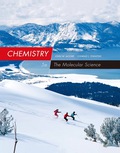
Concept explainers
(a)
Interpretation: The mass fraction and weight percent of
Concept introduction:
Mass fraction: The mass of a single solute divided by the total mass of all solutes and solvent in the solution.
Weight percent: The mass of one component divided by the total mass of the mixture, multiplied by
(a)
Answer to Problem 58QRT
The mass fraction of
Explanation of Solution
- The Mass fraction:
Given information is as follows: Mass of
Mass fraction of
Hence, the mass fraction of
- The Weight percent:
Given information is as follows: Mass of
The weight percent of
(b)
Interpretation: The mass fraction and weight percent of ethanol has to be calculated.
Concept introduction:
Refer to (a):
(b)
Answer to Problem 58QRT
The mass fraction of ethanol is
Explanation of Solution
- The Mass fraction:
Given information is as follows: Mass of ethanol is
Mass fraction of ethanol can be calculated as given below:
Hence, the mass fraction of
- The Weight percent:
Given information is as follows: Mass of ethanol is
The weight percent of ethanol is calculated as shown above. Hence, the weight percent obtained is
(c)
Interpretation: The mass fraction and weight percent of
Concept introduction:
Mass fraction: The mass of a single solute divided by the total mass of all solutes and solvent in the solution.
Weight percent: The mass of one component divided by the total mass of the mixture, multiplied by
(c)
Answer to Problem 58QRT
The mass fraction of
Explanation of Solution
- The Mass fraction:
Given information is as follows: Mass of
Mass fraction of
Hence, the mass fraction of
- The Weight percent:
Given information is as follows: Mass of
The weight percent of
(d)
Interpretation: The mass fraction and weight percent of benzene has to be calculated.
Concept introduction:
Mass fraction: The mass of a single solute divided by the total mass of all solutes and solvent in the solution.
Weight percent: The mass of one component divided by the total mass of the mixture, multiplied by
(d)
Answer to Problem 58QRT
The mass fraction of benzene is
Explanation of Solution
- The Mass fraction:
Given information as: Density of benzene is
Mass of benzene:
Mass fraction of benzene
Hence, the mass fraction of benzene is
- The Weight percent:
The weight percent of benzene is calculated as shown above. Hence, the weight percent obtained is
Want to see more full solutions like this?
Chapter 13 Solutions
EBK CHEMISTRY: THE MOLECULAR SCIENCE
- A solution is made by dissolving 0.455 g of PbBr2 in 100 g of H2O at 50C. Based on the data in Table 8-1, should this solution be characterized as a. saturated or unsaturated b. dilute or concentratedarrow_forwardInsulin is a hormone responsible for the regulation of glucose levels in the blood. An aqueous solution of insulin has an osmotic pressure of 2.5 mm Hg at 25C. It is prepared by dissolving 0.100 g of insulin in enough water to make 125 mL of solution. What is the molar mass of insulin?arrow_forwardThe dispersed phase of a certain colloidal dispersion consists of spheres of diameter 1.0 102 nm. (a) What are the volume (V=43r2) and surface area (A = r2) of each sphere? (b) How many spheres are required to give a total volume of 1.0 cm3? What is the total surface area of these spheres in square meters?arrow_forward
- What is the freezing point and normal boiling point of a solution made by adding 39 mL of acetone, C3H6O, to 225 mL of water? The densities of acetone and water are 0.790 g/cm3 and 1.00 g/cm3, respectively.arrow_forwardWhich solute has the greatest effect on the boiling pointof 1.00 kg of water: 50.0 g of strontium chloride (SrCl2) or 150.0 g of carbon tetrachloride (CCl4) ? Justify youranswer.arrow_forward
 Chemistry: The Molecular ScienceChemistryISBN:9781285199047Author:John W. Moore, Conrad L. StanitskiPublisher:Cengage Learning
Chemistry: The Molecular ScienceChemistryISBN:9781285199047Author:John W. Moore, Conrad L. StanitskiPublisher:Cengage Learning Chemistry & Chemical ReactivityChemistryISBN:9781337399074Author:John C. Kotz, Paul M. Treichel, John Townsend, David TreichelPublisher:Cengage Learning
Chemistry & Chemical ReactivityChemistryISBN:9781337399074Author:John C. Kotz, Paul M. Treichel, John Townsend, David TreichelPublisher:Cengage Learning Chemistry & Chemical ReactivityChemistryISBN:9781133949640Author:John C. Kotz, Paul M. Treichel, John Townsend, David TreichelPublisher:Cengage Learning
Chemistry & Chemical ReactivityChemistryISBN:9781133949640Author:John C. Kotz, Paul M. Treichel, John Townsend, David TreichelPublisher:Cengage Learning Chemistry: Principles and PracticeChemistryISBN:9780534420123Author:Daniel L. Reger, Scott R. Goode, David W. Ball, Edward MercerPublisher:Cengage Learning
Chemistry: Principles and PracticeChemistryISBN:9780534420123Author:Daniel L. Reger, Scott R. Goode, David W. Ball, Edward MercerPublisher:Cengage Learning Chemistry: An Atoms First ApproachChemistryISBN:9781305079243Author:Steven S. Zumdahl, Susan A. ZumdahlPublisher:Cengage Learning
Chemistry: An Atoms First ApproachChemistryISBN:9781305079243Author:Steven S. Zumdahl, Susan A. ZumdahlPublisher:Cengage Learning





